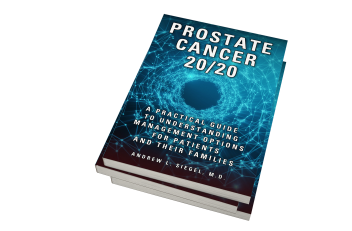Andrew Siegel MD 3/2/19
A doctor-turned-patient friend of mine who also happens to be a medical school professor stated it clearly: “As patients we often forget what we want to ask and forget what we were told.”
One of my missions is to “bridge the gap” that exists between the medical community and the non-medical layperson. This gap is best bridged by providing the education to complement and supplement the office visit, aspiring to answer the questions that were not asked and reinforce the answers to the questions that were asked, enabling informed decisions–after all, the word “doctor” stems from the Latin “docere,” meaning teacher: “The best prescription is knowledge.”
 Attribution of image above: Alpha Stock Images – http://alphastockimages.com/
Attribution of image above: Alpha Stock Images – http://alphastockimages.com/
Facts and epidemiology
Prostate cancer is the most common malignancy — aside from skin cancer — among men in most western populations, with an estimated 165,000 new cases in 2018 in the United States. It is the second leading cause of cancer death, with an estimated 30,000 deaths in 2018 (lung cancer is the leading cause). To put this in perspective, heart disease claims more than 600,000 lives per year in American men and is the leading cause of death in men with prostate cancer. Even in the population of men with prostate cancer, many more men die with it than of it. In fact, there are almost 3 million prostate cancer survivors in the U.S.
Fact: In New Jersey it is estimated that in 2018 there were 5430 new cases of prostate cancer and 750 deaths.
Prostate cancer is unique among tumors in that it exists in two forms: latent (evident on autopsy studies, but not causing an abnormal rectal exam or PSA (prostate specific antigen blood test), present in 60-70% of men older than 80; and clinically evident (causing an abnormal rectal exam and/or elevated PSA), affecting about 1 in 9 men in the U.S. Overall, men have a roughly 11% chance of being diagnosed with prostate cancer and a 3% chance of dying from it. This high ratio of prostate cancer occurrence rate to death rate suggests that many of these cancers do not threaten one’s life and are “indolent” cancers.
Risk factors
The major risk factors for prostate cancer are age, race, family history, and lifestyle. The likelihood of developing prostate cancer increases with aging—the greatest risk factor for prostate cancer—thought to be due to accumulation of DNA mutations from oxidative damage (literally “rusting”) of prostate cells. With each decade of aging, the occurrence of prostate cancer increases considerably. More that 60% of men are 65 years old or older at the time of diagnosis, with average age at diagnosis in the late 60s.
African American men have the highest incidence of prostate cancer,1.6 times that of Caucasian men in the U.S.; furthermore, the death rate for African American men is 2.4 times higher than that of Caucasian men. On a worldwide basis, the greatest occurrence of prostate cancer is in North America and Scandinavia and the lowest in Asia. Prostate cancer is approximately 8 times more prevalent in Western countries than it is in Eastern countries.
Prostate cancer tends to run in families, so it is vital that male children of prostate cancer patients get checked annually starting at age 40 with a PSA blood test and a digital rectal exam of the prostate. (It is my belief that all men should receive an initial baseline PSA and digital rectal exam at age 40.) Risk increases according to the number of affected family members (the more affected, the higher the risk), their degree of relatedness (brother and/or father affected confer a higher risk than cousin and/or uncle) and the age at which they were diagnosed (relatives of patients diagnosed younger than 55 years old are at highest risk). If you have a brother or a father with prostate cancer, your risk of developing it is doubled. If you have three family members with prostate cancer, or if the disease occurs in three generations in your family, or if two of your first-degree relatives have been diagnosed at an age younger than 55 years, you have a good likelihood for having hereditary prostate cancer, which confers a 50% risk of developing the disease.
My father, a retired urologist, was diagnosed with prostate cancer at age 65 and is currently 87 years old and thriving. I have been especially diligent in seeing my internist annually for a PSA blood test and a digital rectal exam of the prostate. Additionally, I have been proactive in taking finasteride to decrease my risk for prostate cancer.
An unhealthy lifestyle is an additional risk factor for prostate cancer. Being overweight or obese and consuming a Western-style diet full of calorie-laden, nutritionally-empty selections (fast food, highly processed and refined foods, excessive sugars, etc.) puts one at greater risk for aggressive prostate cancer as well as dying from prostate cancer. Asian men who reside in Asian countries have the lowest risk for prostate cancer; however, after migrating to Western countries, their risk increases substantially. This is highly suggestive that diet and other lifestyle factors play a strong role in the development of prostate cancer.
Detection
Most prostate cancers are detected by PSA screening. Widespread PSA blood testing has resulted in the increased diagnosis of early, asymptomatic prostate cancer with a reduction in the prostate cancer death rate. This is as opposed to the pre-PSA era when most cancers were detected via an abnormal prostate exam or symptoms due to advanced prostate cancer.
Screening is of vital importance because localized prostate cancer typically causes no symptoms or warning signs whatsoever. Prostate cancer is most commonly diagnosed by a biopsy prompted because of a PSA elevation, an accelerated increase in the PSA over time, or an abnormal digital rectal examination (a bump, lump, hardness, asymmetry, etc.). Those prostate cancers picked up via a PSA elevation or acceleration now account for 75% of all newly diagnosed prostate cancers.
The observed trends in PSA-driven detection of prostate cancer at earlier stages and declining death rates where screening is commonly used point to the benefits of screening. If prostate cancer is not actively sought, it is not going to be found. When prostate cancer does cause symptoms, it is generally a sign of locally advanced or advanced prostate cancer and therein lies the importance of screening. The downside of screening is over-detection of low risk prostate cancer that may never prove to be problematic but may result in unnecessary treatment with adverse consequences. The downside of not screening is the under-detection of aggressive prostate cancer, with adverse consequences from necessary treatment not being given.
Urologists’ challenge
The challenge for those of us who treat prostate cancer is to distinguish between clinically significant (“aggressive”) and clinically insignificant (“indolent”) disease and to decide the best means of treating clinically significant disease to maintain quantity and quality of life.
Natural history of prostate cancer
The good news is that when detected early, clinically significant prostate cancer is highly curable. However, such prostate cancers if left untreated have a slow, steady and predictable behavior with potential for local tumor progression and spread. Death from prostate cancer is unpleasant, often involving painful cancer spread to the spine and pelvis and not uncommonly kidney and bladder obstruction. Thus, early treatment is an important consideration for men with a life expectancy exceeding 10 years. When prostate cancer is treated, it is with the intent of avoiding the long-term consequences, i.e., that which might occur 10, 15 and 20 years down the line. Even when prostate cancer is not discovered early, although not necessarily curable, it is most often a manageable condition.
Team approach
I embrace the concept of the multi-disciplinary health care team approach to prostate cancer. In addition to the urologist, the physicians who specialize in prostate cancer are the radiation oncologist and the medical oncologist. This trio may be considered the prostate cancer team and are a powerful combination in terms of their ability to educate and guide management. Each member of the team has a different expertise and skillset and contributes vitally to the decision-making and management process.
Not surprisingly, physicians have inherent biases directly related to their training. In general, the urological surgeon’s bias is towards favoring surgery, the radiation oncologist’s is radiation therapy and the medical oncologist’s is chemotherapy. I have made great efforts to get beyond my inherent surgical bias and to give honest and appropriate advice to my patients, based upon the “big picture.” I strongly believe that all physicians should practice the FBSU test (Father, Brother, Son, Uncle test)—giving their patients the same advice they would give to their own family members.
Wishing you the best of health,
![]()
A new blog is posted weekly. To receive a free subscription with delivery to your email inbox visit the following link and click on “email subscription”: www.HealthDoc13.WordPress.com
Dr. Andrew Siegel is a physician and urological surgeon who is board-certified in urology as well as in female pelvic medicine and reconstructive surgery. He is an Assistant Clinical Professor of Surgery at the Rutgers-New Jersey Medical School and is a Castle Connolly Top Doctor New York Metro Area, Inside Jersey Top Doctor and Inside Jersey Top Doctor for Women’s Health. He is a urologist at New Jersey Urology, the largest urology practice in the United States.
The content of this entry is excerpted from his new book, PROSTATE CANCER 20/20: A Practical Guide to Understanding Management Options for Patients and Their Families

Preview of Prostate Cancer 20/20
Video trailer for Prostate Cancer 20/20
Dr. Siegel is the author of 4 other books:
PROMISCUOUS EATING— Understanding and Ending Our Self-Destructive Relationship with Food
MALE PELVIC FITNESS: Optimizing Sexual and Urinary Health
THE KEGEL FIX: Recharging Female Pelvic, Sexual, and Urinary Health
Andrew Siegel MD Amazon author page
Prostate Cancer 20/20 on Apple iBooks
Tags: Andrew Siegel MD, prostate cancer, Prostate Cancer 20/20, prostate cancer epidemiology, prostate cancer risk factors, prostate cancer screening
Leave a comment